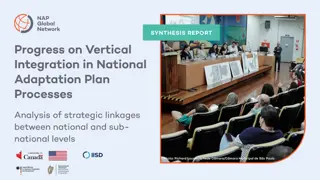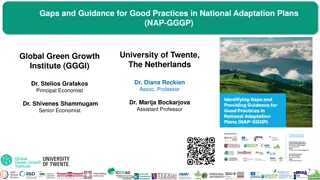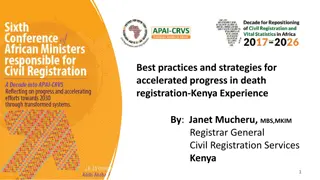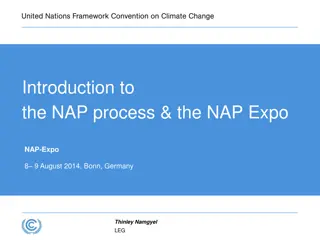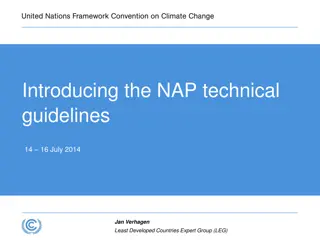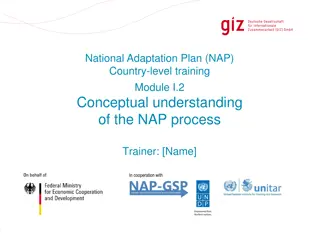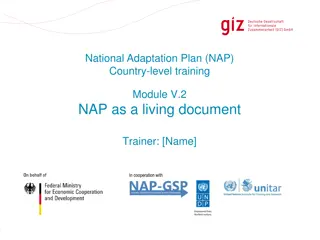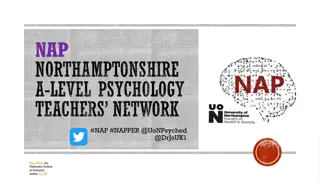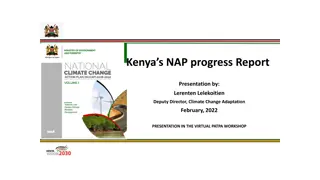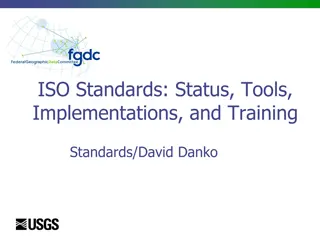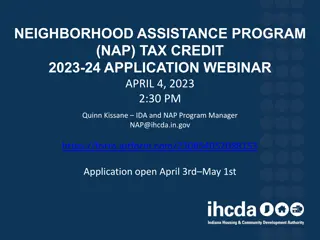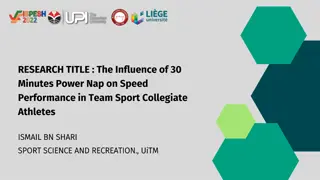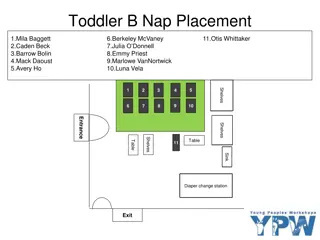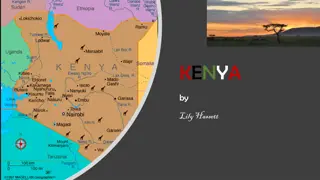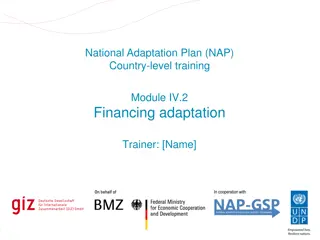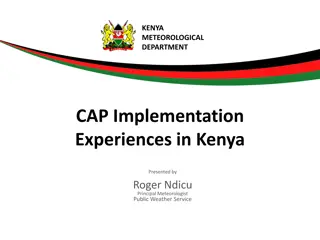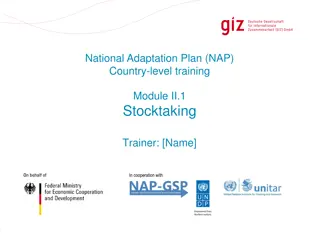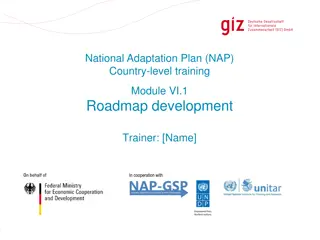
Accelerating Climate Adaptation: Kenya's NAP Journey
Explore Kenya's decade-long journey in formulating and implementing their National Adaptation Plan (NAP) from 2012 to 2025. Discover the challenges, innovations, and lessons learned in addressing climate change impacts, why adaptation is a priority for Kenya, and the key role of the National Climate Change Council in coordinating climate action at all levels.
Download Presentation

Please find below an Image/Link to download the presentation.
The content on the website is provided AS IS for your information and personal use only. It may not be sold, licensed, or shared on other websites without obtaining consent from the author. If you encounter any issues during the download, it is possible that the publisher has removed the file from their server.
You are allowed to download the files provided on this website for personal or commercial use, subject to the condition that they are used lawfully. All files are the property of their respective owners.
The content on the website is provided AS IS for your information and personal use only. It may not be sold, licensed, or shared on other websites without obtaining consent from the author.
E N D
Presentation Transcript
REGIONAL EXCHANGE DIALOGUE ON ACCELERATING SUPPORT FOR THE FORMULATION ANO IMPLEMENTATION OF NATIONAL ADAPTATION PLANS (NAPS) IN THE EAST AND SOUTHERN AFRICAN REGION 04 Jun. 2025
Sharing Experiences in NAP Formulation and Implementation Kenya's National Adaptation Plan: A Decade of Implementation, Innovation, and Learning Based on Kenya s NAP 2015 2030 and Implementation experience Faith Agnes Ondeng Knowledge Management Technical Officer Climate Change Directorate, Kenya (embedded through NDC Partnership) Faith Agnes Ondeng
Kenya's NAP Journey: 2012-2025 Four Pillars of Our Implementation Approach Innovative Financing Mechanisms Key Lessons Learned and Challenges Recommendations for Regional Partners Overview Faith Agnes Ondeng
Our Climate Adaptation Journey 2012: NAP development initiated 2015: NAP finalized (2015- 2030) 2017: NAP submitted to UNFCCC 2016: Climate Change Act enacted 2025: Nearly a decade of implementation lessons 2018: County Climate Change Funds piloted 2020: CCCF scaled to all 47 counties Faith Agnes Ondeng
Kenyas Climate challenge: Why Adaptation is Kenya's Priority Climate Impacts: 80% of land is arid and semi-arid (ASAL) Droughts every 3-4 years (economic losses: 3-5% GDP annually) 2008-2011 drought: USD 12.1 billion in damages Vulnerable Sectors: Agriculture (25% of GDP) Tourism (10% of GDP) Pastoralism (majority livelihood in ASALs) Kenya Post-Disaster Needs Assessment for 2008-2011 Drought (2012), Kenya National Adaptation Plan 2015-2030, pages 15- 19, Kenya s UNFCCC submission (2024) Faith Agnes Ondeng
National Climate Change Council Chaired by the President Cabinet Secretary as Secretary Climate Change Directorate Lead government agency Climate Change Units All 47 counties All major ministries Key Success: Clear coordination from President to community level Implementation Implementation Pillar 1: Pillar 1: Institutional Institutional Framework. Framework. Building Strong Governance for Climate Action Climate Change Act, 2016, Part II: Policy, Coordination and Oversight Kenya National Adaptation Plan 2015-2030, Chapter 2 Kenya's UNFCCC submission (2024). Faith Agnes Ondeng
NCCAP 1 (2013-2017): Institutional setup, pilot projects NCCAP 2 (2018-2022): CCCF expansion, capacity building NCCAP 3 (2023-2027): Innovation, private sector engagement Why This Works: Matches political cycles Allows learning and adaptation Manageable resource planning Implementation Pillar 2: Implementation Pillar 2: 5 5- -Year Cycles Year Cycles Breaking the 15-Year NAP into Manageable Phases Kenya's UNFCCC submission (2024), National Climate Change Action Plans (NCCAP 2013-2017, 2018-2022, 2023-2027) Kenya National Adaptation Plan 2015-2030, Chapter 4 Faith Agnes Ondeng
Implementation Pillar 3: Sectoral Mainstreaming Implementation Pillar 3: Sectoral Mainstreaming Climate Action Across All Government Sectors Economic Pillar: Tourism, Agriculture, Trade, Manufacturing 20 Economic Planning Sectors Integrated Social Pillar: Education, Health, Water, Housing Political Pillar: Devolution Result: Climate considerations automatic, not afterthought Key Stat: Climate change integrated into all sector budgets and plans Foundation Pillar: Infrastructure, ICT, Energy, Transport Faith Agnes Ondeng
Implementation Pillar 4: Devolved Climate Finance Implementation Pillar 4: Devolved Climate Finance Innovation That Changed Everything: County Climate Change Funds Kenya's UNFCCC submission (2024); FLLoCA program documentation The Innovation: Direct climate finance to county level Community participation in priority setting Integration with government systems The Numbers: All 47 counties have CCCFs Minimum 1.5% county development budget to climate Scaled through FLLoCA program Community Impact: Faster implementation Higher ownership and sustainability More relevant to local needs Faith Agnes Ondeng
International Climate Finance: Financing Financing Strategy Strategy Multiple Sources, Multiple Mechanisms GCF: USD 23 million (ecosystem adaptation) Adaptation Fund: USD 10 million (community resilience) GCF Readiness: USD 3 million (capacity building) Domestic Commitment: Counties: 1.5% development budget annually National budget integration across sectors Innovation: CCCF mechanism for predictable funding Private sector engagement (CBIN-K) Faith Agnes Ondeng
1. Devolved Climate Finance Problem: Money took years to reach communities Solution: Direct county climate funds Result: Faster, more effective projects Three Innovations That Made the Difference Kenya's UNFCCC submission (2024), Section 3.0 (Best Practices) Kenya National Adaptation Plan 2015-2030, Section 3.3-3.5 Climate Change Directorate implementation reports 2. Government System Integration Problem: Parallel donor systems created chaos Solution: All climate finance through government systems Result: Sustainable, accountable management 3. Indigenous Knowledge Integration Problem: Scientific and traditional knowledge separate Solution: Combined forecasting (e.g., Nganyi "rain makers") Result: More accurate, trusted information Faith Agnes Ondeng
Concrete Results After 10 Years Ending Drought Emergencies (EDE) Program: 10-year investment in 23 ASAL counties Reduced people affected by drought despite more frequent droughts County Climate Funds: All 47 counties implementing climate actions Communities directly involved in project selection Capacity Building: All counties have trained climate units Systematic knowledge transfer and peer learning Faith Agnes Ondeng
What We've Learned That Could Help You Start with Strong Foundations: Legal framework with highest political support Permanent institutions, not temporary projects Systematic capacity building Design for Implementation: Break long-term plans into manageable cycles Use existing government systems Ensure genuine community participation Innovation in Financing: Demonstrate domestic commitment first Create direct community access mechanisms Engage private sector as partners, not just donors Faith Agnes Ondeng
What We're Still Working On Ongoing Challenges: Financing gap: USD 44 billion need vs available resources Coordination complexity across 47 counties and 20 sectors Long-term nature of adaptation benefits Lessons Learned: Sustained investment over time is essential Adaptation requires patient capital Community ownership is non-negotiable Political continuity through institutional frameworks Faith Agnes Ondeng
For Countries Starting NAPs: Begin with institutional framework Pilot community-level mechanisms Document everything for learning For Countries Implementing: Share innovations and lessons Coordinate with regional partners Advocate collectively for adaptation finance Regional Opportunities: Cross-border adaptation projects Shared early warning systems Knowledge exchange platforms Faith Agnes Ondeng
Let's Continue Learning Together Kenya's Commitment: Share detailed implementation guides Provide technical assistance for CCCF replication Participate in regional learning networks Faith Agnes Ondeng
Dr. Pacifica Ogola Director, Climate Change Directorate, State Department of Environment and Climate Change, and UNFCCC Focal Point Mr. Lerenten Lelekoitien Deputy Director, Adaptation and Focal Point Climate Change Directorate, State Department of Environment and Climate Change Email: lerenten12@gmail.com Contact Information Faith Agnes Ondeng Knowledge Management Technical Officer Climate Change Directorate, State Department of Environment and Climate Change Email: faithakinyi.nyaruwe@gmail.com Faith Agnes Ondeng
Kenya National Adaptation Plan (2015- 2030). Ministry of Environment and Natural Resources, July 2016 Kenya s Submission to the UNFCCC on NAP Progress. Republic of Kenya, February 2024 Climate Change Act, 2016. Reports Kenya Post-Disaster Needs Assessment for 2008-2011 Drought. Republic of Kenya, 2012 National Climate Change Action Plans (NCCAP 2013-2017, 2018-2022, 2023- 2027) Ending Drought Emergencies Common Programme Framework 2012-2022 NAP Global Network Community Stories: https://napglobalnetwork.org/stories/thriv ing-in-dry-times/ KEY REFERENCES Faith Agnes Ondeng
Closing Message Enhanced climate resilience towards Vision 2030 together Faith Agnes Ondeng

